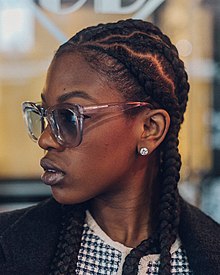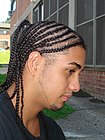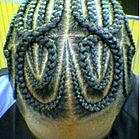Cornrows

Cornrows (sometimes called canerows) are a style of traditionally three-strand braids, originating in Africa,[1][2][3] in which the hair is braided very close to the scalp, using an underhand, upward motion to make a continuous, raised row. Cornrows are often done in simple, straight lines, as the term implies, but they can also be styled in elaborate geometric or curvilinear designs. They are distinct from, but may resemble, box braids, Dutch braids, melon coiffures, and other forms of plaited hair, and are typically tighter than braids used in other cultures.[4]
The name may refer to the corn fields or sugar cane fields of the Americas and Caribbean.[5][6] According to black folklore, cornrows were often used to communicate on the Underground Railroad and by Benkos Biohó during his time as a slave in Colombia.[7] They often serve as a form of black self-expression.[8] Cornrows are traditionally called "kolese" or "irun didi" in Yoruba, and are often nicknamed "didi braids" in the Nigerian diaspora.[9]
Cornrows are worn by both sexes, and are, on some occasions, adorned with beads, hair cuffs, or cowrie shells. The duration of weaving cornrow braids may take up to five hours, depending on the quantity and width.[10] Often favored for their easy maintenance, cornrows can be left in for weeks at a time if maintained through careful washing of the hair and natural oiling of the scalp. Braids are considered a protective styling on African curly hair as they allow for easy and restorative growth; braids pulled too tightly or worn for longer lengths of time and on different hair types can cause a type of hair loss known as traction alopecia.[11]
History
Africa

Modern cornrows are most closely associated with Black people in the Americas,[12] including the USA and Caribbean,[13] but are thought to come from older African traditions.[14][15] Depictions of women with what appear to be cornrows have been found in Stone Age paintings in the Tassili Plateau of the Sahara, and have been dated as far back as 3000 B.C. A similar style is also seen in depictions of the ancient Cushitic people of the Horn of Africa, who appear to be wearing this style of braids as far back as 2000 B.C.[16]
In Africa, cornrows have been documented in the ancient Nok civilization in Nigeria,[17] in the Mende culture of Sierra Leone,[18] and the Dan culture of the Côte d'Ivoire.[14] In Ethiopia and Eritrea, there are many braided hairstyles which may include cornrows or "shuruba", such as Habesha or Albaso braids, and Tigray shuriba.[19][20] Though such hairstyles have always been popular with women, Ethiopian men have also worn such hairstyles. In 19th century Ethiopia, male warriors and kings such as Tewodros II and Yohannes IV were depicted wearing braided hairstyles, including the shuruba.[21][22][23] Cornrow hairstyles in Africa also cover a wide social terrain: religion, kinship, status, age, racial diversity, and other attributes of identity can all be expressed in hairstyle. Just as important is the act of braiding, which passes on cultural values between generations, expresses bonds between friends, and establishes the role of professional practitioner.[17]
Europe

Though controversial, there have been a number of examples of European art and sculpture alleged to depict hairstyles similar to modern cornrows, though this is contested by modern scholars.[25]

The oldest of these depictions are the statues known as the Venus of Brassempouy[25][26] and the Venus of Willendorf,[27][28][29] which date between 23,000 and 29,000 years ago[30] and were found in modern day France and Austria. Whether these statues feature cornrows, another type of braids, headdresses, or some other styling has been a matter of vigorous debate — some historians rule out cornrows, however.[25][27] The Venus of Brassempouy is often said to wear a wig or a patterned hood,[31] while the Venus of Willendorf is said to be wearing plaited hair or a fibrous cap.[27]
Since the early 5th century B.C., Ancient Greek and Roman art shows men and women with a characteristic melon coiffure, especially in the "Oriental Aphrodite" tradition, which may be confused with cornrows.[32][33][34] The traditional hairstyle of Roman Vestal Virgins, the sini crenes, also incorporates two braids that resemble cornrows.[35][36][37]
Americas
The first recorded use of the word "cornrow" was in America in 1769, referring to the corn fields of the Americas. The earliest recorded use of the term "cornrows" to refer a hairstyle was in 1971; the name "canerows" may be more common in parts of the Caribbean due to the historic role of sugar plantations in the region.[5][6]
Enslaved Black people may have worn cornrows as one way to keep their hair neat and flat to their scalp while working; the other styles they developed alongside these may have blended African, European and Native American trends and traditions.[38] African-American, Afro-Latino and Caribbean folklore relates multiple stories of cornrows being used to communicate or provide maps for slaves across the "New World".[7] Today, such styles retain their link with Black self-expression and creativity, and may also serve as a political expression.[8][39][40]
Cornrows made a comeback in the United States in the 1960s and 1970s, and returned again during the 1990s and 2000s. In the 2000s, some athletes wore cornrows, including NBA basketball players Allen Iverson, Rasheed Wallace, and Latrell Sprewell.[41] Some female mixed martial artists have chosen to wear cornrows for their fights as it prevents their hair from obscuring their vision as they move.[42][43][44]
Controversy

Over the decades, cornrows, alongside dreadlocks, have been the subject of several disputes in U.S. workplaces, as well as universities and schools. Some employers and educational institutions[45] have considered them unsuitable and banned them.[41] Employees and civil rights groups have countered that such attitudes evidence cultural bias or racism, and some disputes have resulted in litigation.[46]
In 2011, the High Court of the United Kingdom, in a decision reported as a test case, ruled against a school's decision to refuse entry to a student with cornrows. The school claimed this was part of its policy mandating "short back and sides" haircuts, and banning styles that might be worn as indicators of gang membership. However, the court ruled that the student was expressing a tradition and that such policies, while possibly justifiable in certain cases (e.g. skinhead gangs), had to accommodate reasonable racial diversities and cultural practices.[47]
In the US state of California, the CROWN Act was passed in 2019 to prohibit discrimination based on hair style and hair texture.[48]
Gallery
-
Styled cornrows
-
Cornrows
-
Artistic braiding
-
The Venus of Brassempouy, controversially argued to have cornrows
See also
References
- ^ "Cornrow". Dictionary.com. Retrieved 27 February 2024.
- ^ Horne, Madison (28 February 2018). "A Visual History of Iconic Black Hairstyles". History.com.
- ^ "History of Braids: More Than Just a Hairstyle". Genesis Career College. Retrieved 27 February 2024.
- ^ Underwood, Khalea (24 August 2019). "Cornrows, Braids, Twists, Oh My: How To Spot The Difference In Braiding Styles". Refinery29. Retrieved 27 February 2024.
- ^ a b Charlotte Mensah (29 October 2020). Good Hair: The Essential Guide to Afro, Textured and Curly Hair. Penguin Books Limited. p. 42. ISBN 978-0-241-98817-6.
- ^ a b "cornrow (noun)". Oxford English Dictionary. Retrieved 27 February 2024.
- ^ a b Irbahim, Nur (12 March 2022). "Did Braiding Maps in Cornrows Help Black Slaves Escape Slavery?". Snopes. Retrieved 27 February 2024.
- ^ a b Dash, Paul (31 January 2006). "Black hair culture, politics and change". International Journal of Inclusive Education. 10 (1): 27–37. doi:10.1080/13603110500173183. ISSN 1360-3116.
- ^ Kia, Kara (5 February 2021). "It's Time We Ditch the Words "Cornrows" and "Canerows" and Call Them Didi Braids Instead". POPSUGAR Beauty UK. Retrieved 29 February 2024.
- ^ "Cornrow Braid Styles". Africanamericanhairstyling. Archived from the original on 26 July 2018. Retrieved 11 August 2018.
- ^ "Braiding 'can lead to hair loss'". BBC News. 24 August 2007. Retrieved 30 April 2010.
- ^ Green, Ashley Turner,Dymond (17 August 2018). "The black hair care industry generates billions — but the US is missing out on the market". CNBC. Retrieved 1 March 2024.
{{cite web}}: CS1 maint: multiple names: authors list (link) - ^ Galla, Brittany (6 July 2013). "Heidi Klum Bikini Pic: Star Flashes Butt, Shows Off Cornrow Hair". Us Weekly. Retrieved 1 March 2024.
- ^ a b "History of Cornrow Braiding: African Orgins 1.d". ccd.rpi.edu. 12 June 2011. Archived from the original on 12 June 2011. Retrieved 1 March 2024.
- ^ "The evolution of cornrows - Reader's Digest". www.readersdigest.co.uk. Retrieved 27 February 2024.
- ^ Willie F. Page, ed. (2001). Encyclopedia of African history and culture: Ancient Africa (prehistory to 500 CE), Volume 1. Facts on File. p. 36. ISBN 978-0816044726.
- ^ a b "History of Cornrow Braiding: African Origins 1.b". Csdt.rpi.edu. Archived from the original on 23 June 2015. Retrieved 20 June 2015.
- ^ "History of Cornrow Braiding: African Origins1.c". ccd.rpi.edu. 12 June 2011. Archived from the original on 12 June 2011. Retrieved 1 March 2024.
- ^ Staff, Shine My Crown (20 June 2023). "Albaso Braids: Modern Ethiopian Braids & Hairstyles". Shine My Crown. Retrieved 1 March 2024.
- ^ "20 Ethiopian Hairstyle Ideas – Forever Braids". 4 October 2022. Retrieved 1 March 2024.
- ^ "African Ghana Wall Mask, Woman with Braided Hair, Hand Carved Ebony". Roadshow Collectibles. Retrieved 1 March 2024.
- ^ Ali, Kiya (16 April 2019). "Returning to Roots: Braids Make a Comeback". Ethiopian Business Review. Retrieved 1 March 2024.
- ^ Aning, Laurencia. "A hair journey through time | Hair Journey with Laurencia". blogs.brighton.ac.uk. Retrieved 1 March 2024 – via University of Brighton.
- ^ Carlberg, Andrea HanelCarsten (3 July 2020), English: History of human pigmentation in Europe., retrieved 15 May 2024
- ^ a b c Randall White (December 2006). "The Women of Brassempouy: A Century of Research and Interpretation" (PDF). Journal of Archaeological Method and Theory. 13 (4): 251–304. doi:10.1007/s10816-006-9023-z. S2CID 161276973..
- ^ "Echoes of the Past: Prehistoric Wonders in Southern France". France Today. 30 September 2021. Retrieved 16 May 2022.
- ^ a b c "Woman from Willendorf" Archived 2007-10-05 at the Wayback Machine. Christopher L. C. E. Witcombe, 2003: "The rows are not one continuous spiral but are, in fact, composed in seven concentric horizontal bands that encircle the head and two more horizontal bands underneath the first seven on the back of the head."
- ^ Shaw Nevins, Andrea (2006). The embodiment of disobedience : fat black women's unruly political bodies. Lanham, MD. ISBN 978-0-7391-5457-1. OCLC 856869915.
{{cite book}}: CS1 maint: location missing publisher (link) - ^ Shell, Ellen Ruppel (2003). The hungry gene : the inside story of the obesity industry (1st Grove Press ed.). New York: Grove Press. ISBN 0-8021-4033-5. OCLC 53434322.
- ^ "The earliest artistic depiction of a hairstyle | New Scientist". www.newscientist.com. Retrieved 27 February 2024.
- ^ Lawson, Andrew (24 May 2012). Painted Caves: Palaeolithic Rock Art in Western Europe. Oxford University Press. p. 47. ISBN 978-0-19-969822-6.
- ^ "Seated Nude Woman with "Melon Coiffure"". Fordham University Libraries. Retrieved 27 February 2024.
- ^ "The Herculaneum Women". The J. Paul Getty Museum. Retrieved 27 February 2024.
- ^ "Hairstyles in the Arts of Greek and Roman Antiquity". Journal of Investigative Dermatology Symposium Proceedings. 16 December 2015. Retrieved 27 February 2024.
- ^ León, Vicki (2013). Working IX to V : orgy planners, funeral clowns, and other prized professions of the ancient world. New York. p. 18. ISBN 978-0-8027-1862-4. OCLC 879285569.
{{cite book}}: CS1 maint: location missing publisher (link) - ^ "Oldest Roman Hairstyle Recreated for First Time". LiveScience. 9 January 2013. Retrieved 13 February 2019.
- ^ "Ancient Roman Vestal Virgin hairstyle re-created for very first time". Gizmodo. 11 January 2013. Retrieved 16 May 2022.
- ^ "History of Cornrow Braiding: Middle Passage 2.b". ccd.rpi.eduvvv. Archived from the original on 12 June 2011. Retrieved 1 March 2024.
- ^ Jaima, Felicitas R. (2 September 2017). "When things get hairy: afros, cornrows, and the desegregation of US military hair salons in West Germany". African and Black Diaspora. 10 (3): 269–280. doi:10.1080/17528631.2017.1363477. ISSN 1752-8631.
- ^ Chapman, Yolanda (28 November 2007). ""I am Not my Hair! Or am I?": Black Women's Transformative Experience in their Self Perceptions of Abroad and at Home". Anthropology Theses. doi:10.57709/1059174.
- ^ a b Sherrow, Victoria (2006). Encyclopedia of Hair: A Cultural History. Greenwood Publishing Group. p. 97. ISBN 9780313331459.
- ^ "For Professional Fighters, Hairstyles Can Make the Difference Between Winning and Losing". Allure. 23 June 2021. Retrieved 1 March 2024.
- ^ "Michaela Angela Davis on the Power of Protective Hairstyles". Allure. 20 November 2020. Retrieved 1 March 2024.
- ^ Dsalita (8 November 2023). "why do female mma fighters have cornrows". Dsalita Boxing. Retrieved 1 March 2024.
- ^ Harris, Sherry. "Cornrows: History, Controversy & Freedom of Expression". Sherry's Life. Archived from the original on 14 August 2016. Retrieved 28 August 2016.
- ^ Alison Dundes Renteln (2005). The Cultural Defense. Oxford University Press. p. 143. ISBN 9780195154030. Retrieved 10 August 2011.
- ^ "School braids ban 'not justified'". The Independent. 17 June 2011. Retrieved 17 June 2011.
- ^ "California becomes first state to ban discrimination against natural hair". www.cbsnews.com. 4 July 2019. Retrieved 13 May 2021.
External links




